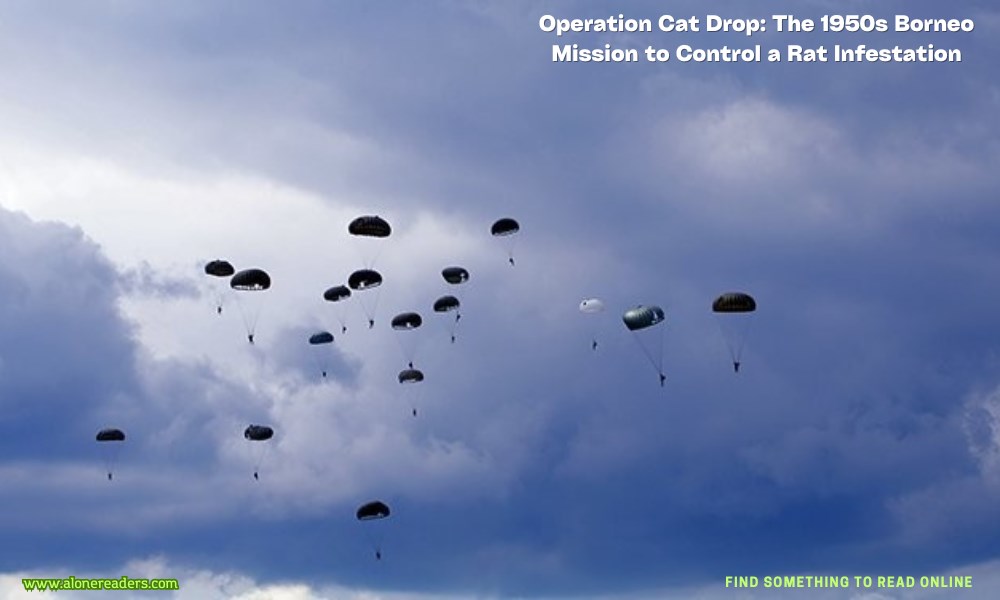
In the annals of history, there are numerous oddities and peculiar events, but few are as strange as Operation Cat Drop, a unique mission in the 1950s that saw cats being parachuted into the jungles of Borneo. This operation was not a whimsical exercise but a calculated response to a significant problem: a rat infestation that had spiraled out of control, exacerbating a typhus outbreak among the local population.
The story begins with the British colonial administration in Borneo, now part of Malaysia and Indonesia, facing a severe health crisis. In the early 1950s, the island was gripped by a typhus epidemic, a disease transmitted by lice and fleas, which had devastating effects on the inhabitants. In an effort to combat the disease, health officials employed a common practice of the time—spraying large quantities of the insecticide DDT (Dichloro-Diphenyl-Trichloroethane) to eliminate the lice and fleas.
Initially, the use of DDT seemed successful. The incidence of typhus began to decline as the lice and flea populations were decimated. However, this intervention had unintended consequences. The DDT also killed a large number of insects that were a food source for the local gecko population. With fewer insects to eat, the gecko numbers plummeted, leading to a cascade of ecological impacts.
Geckos were natural predators of caterpillars, and with fewer geckos, the caterpillar population exploded. These caterpillars, in turn, fed on the thatched roofs of the local houses, causing significant structural damage. However, the most severe consequence of the DDT spraying was yet to unfold. The geckos were also a primary food source for the island’s population of cats.
As the geckos dwindled, so did the cats, either through direct poisoning from consuming insects with high DDT concentrations or through starvation. This created a vacuum in the food chain, which the rats quickly exploited. Without cats to keep their numbers in check, the rat population surged. Rats, being vectors for fleas that carry diseases like typhus, exacerbated the public health crisis the DDT was supposed to alleviate.
Faced with this unintended and worsening situation, health officials had to devise a new plan. This is where Operation Cat Drop comes into the picture. In a bid to control the burgeoning rat population, the British Royal Air Force was enlisted to airdrop cats into the most affected areas of Borneo. It was an unprecedented operation that involved strapping cats into specially designed parachutes and releasing them from planes.
The logistics of this operation were complex. The cats needed to be securely and safely transported, ensuring they would survive the drop and be able to adapt to their new environment upon landing. Reports suggest that the cats were dropped in crates, which would open upon impact, allowing the cats to roam free and start hunting the rats.
The sight of cats descending from the skies over Borneo must have been extraordinary and surreal for the local population. Yet, this bizarre intervention had a practical purpose. The cats quickly adapted to their surroundings and began to do what they do best—hunt rats. Over time, their presence helped to reduce the rat population, thereby mitigating the risk of typhus transmission via rat fleas.
Operation Cat Drop is a fascinating example of how human interventions in nature can sometimes lead to unforeseen and complex ecological consequences. It underscores the delicate balance within ecosystems and the interconnectedness of various species. The initial use of DDT to solve a health crisis inadvertently disrupted the ecological equilibrium, leading to a series of problems that required an equally unconventional solution.
This operation also highlights the ingenuity and adaptability of humans in the face of crises. While parachuting cats into a jungle might sound like a scene from a surreal story, it was a pragmatic response to an urgent problem. The success of the operation is a testament to the resilience and resourcefulness of both the officials who devised the plan and the cats who executed it.
In the broader context, Operation Cat Drop serves as a cautionary tale about the potential consequences of human actions on the environment. It reminds us that every intervention, no matter how well-intentioned, can have ripple effects throughout an ecosystem. Understanding these dynamics is crucial for making informed decisions that minimize negative impacts on the natural world.
In conclusion, Operation Cat Drop is a remarkable chapter in the history of public health and ecological management. It combines elements of bizarre ingenuity and serious environmental science, illustrating the complexities and challenges of managing human health and ecological balance. While the image of cats parachuting into the jungle is undoubtedly striking, the underlying lessons of this operation remain profoundly relevant today.